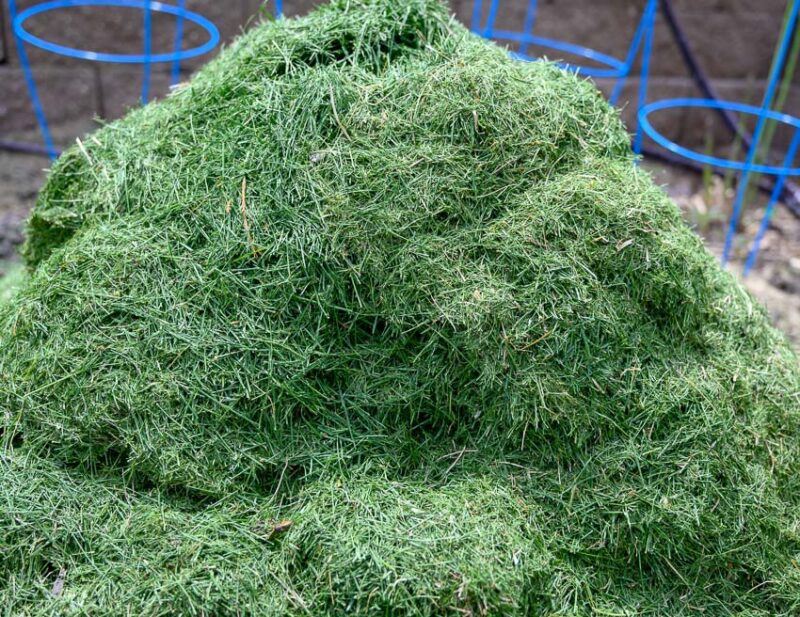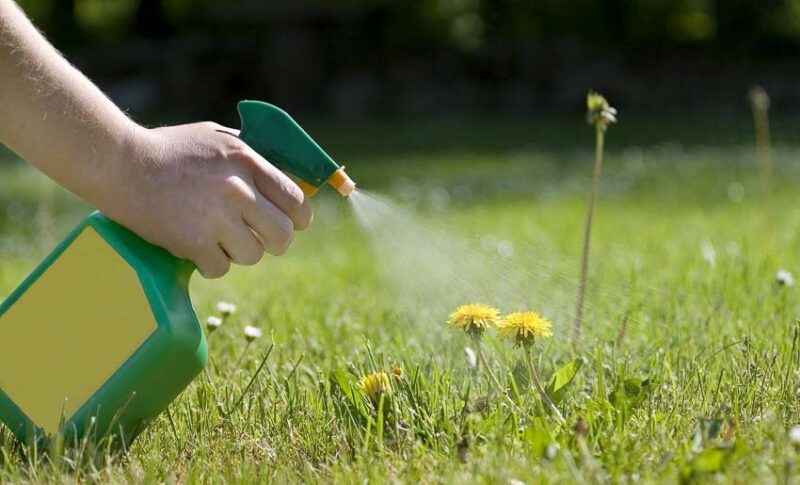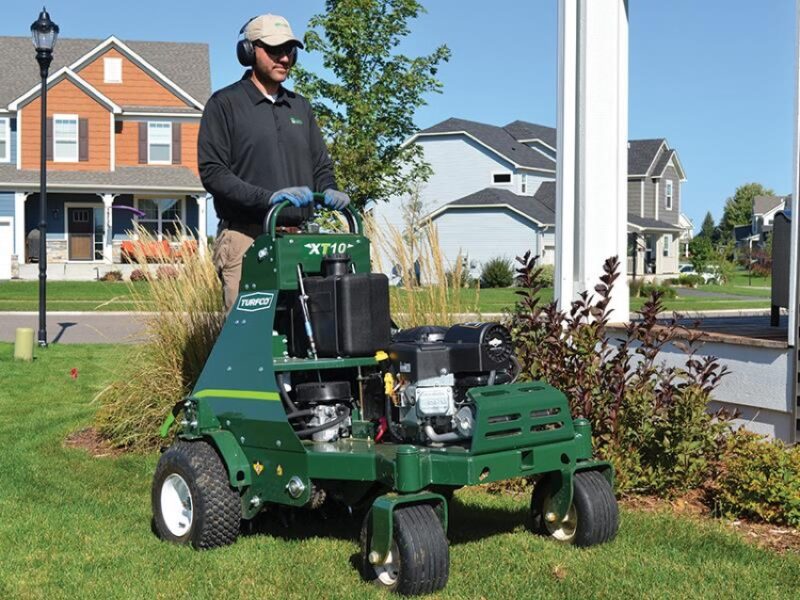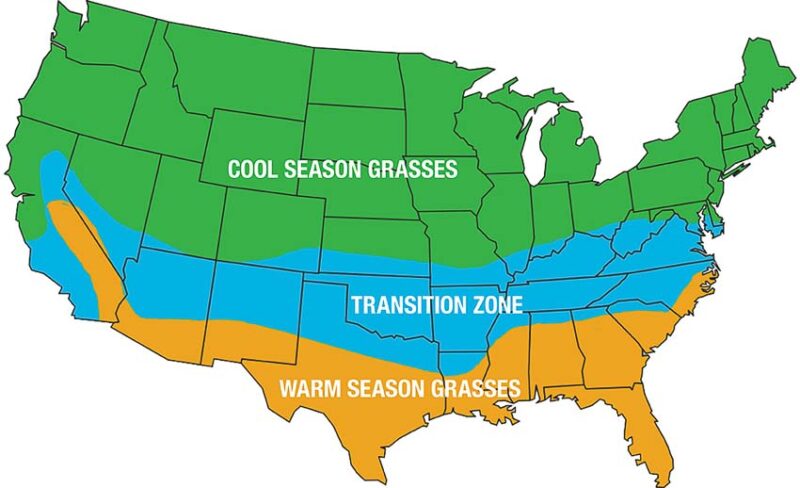The latter months of the year bring cooler weather and less sunlight, signaling lawns to start slowing their growth. This allows you to take a break from your strict summer lawn care regimen to prepare for the upcoming winter dormancy. In this guide, we’ll go over proper fall lawn care and maintenance for both northern and southern regions so that your lawn bounces back healthy and vibrant in the spring.
Fall Lawn Care for Northern Regions
In northern climates, fall brings cooler temperatures, fewer daylight hours, and sometimes, snow. For these reasons, it’s important to prepare your lawn adequately for the season.
Keep Mowing, Gradually Lowering Blades

Just because your grass has slowed its growth, doesn’t mean you should stop your mowing schedule. In fact, it’s vital to your lawn’s health to keep mowing it regularly. While you can lessen the mowing frequency, you should maintain a schedule of mowing at least every 10 to 14 days to keep your grass healthy.
When you mow in the fall, you should lower the mower blades every session. As fall comes to a close, you’ll want your grass to be 2 to 2.5 inches tall. This helps prevent diseases and ensures the grass is at an optimal length to withstand the coming winter conditions.
Mulch and Recycle Clippings

After you complete each mow, it’s beneficial to mulch or collect and dispose of your grass clippings. Both practices will prevent the clippings from smothering the grass underneath, which can cause bare patches.
Mulching blades can also help you manage fallen leaves by shredding them into the lawn. Not only does this process prevent patchiness, but it also adds nutrients to the soil, enhancing its fertility and health.
Overseed and Fertilize
For cool-season grasses, the best time to overseed and fertilize is in September. Overseeding can help you fill in thin or bare patches in your lawn, encouraging a lush and thick lawn before winter starts. For best results, choose a seed mix containing ryegrass and fescues.
This is also a prime time for aeration. After you aerate your lawn, distribute the seed evenly and then follow up with a high-phosphorus fertilizer to nurture root growth and establishment.
Monitor Irrigation
As temperatures cool, your lawn doesn’t require as much water. However, be on the lookout for signs of drought stress. Even during the fall, you should provide around 1 inch of water per week. Continue this practice until early November, and then gradually stop watering to allow your lawn to acclimate and prepare for dormancy.
Treat Weeds During Fall Lawn Care

Stay vigilant about tackling persistent weeds in the autumn months using targeted herbicidal sprays. To handle weed issues preemptively, you can apply herbicides that hinder weed germination and growth during cooler periods. Since this is when desirable grass varieties enter dormancy, this process ensures a weed-free lawn in the spring.
Rake and Remove Leaves
Continue raking any fallen leaves consistently, or use something like a lawn sweeper or mower with a bagging attachment. Avoid leaving large piles of leaves on your lawn, since it can obstruct sunlight and cause dead patches to form.
After collecting, you can also recycle shredded leaves to use as a rich source of compost or mulch.
Prepare for Winter
Towards the end of November, if your yard is still free from snow, you can do one final mowing session of the season. Set your mower to the lowest recommended setting depending on your grass type. Having a short lawn going into winter can minimize the risk of developing fungal diseases like snow mold.
As growth stops, you can move on to winterize irrigation systems to ensure they don’t get damaged during the upcoming freeze. This is also a great time to give your lawn equipment a good cleanup and maintenance check.
Fall Lawn Care for Southern Regions
Meanwhile, the southern regions of the U.S. experience milder winter temperatures. Because of this, lawn care requires a different approach. Although temperatures in the south tend to be warmer than in the north, there are still steps you can take to maintain a lush lawn that can withstand the winter months.
Continue Mowing Weekly
Warm-season grasses like Bermuda and Zoysia remain vigorous well after the start of fall. They require weekly mowing to stay healthy. Aim for a height of 2 to 3 inches for a neat and groomed lawn.
As leaves begin to drop, you may need to raise your mowing frequency to keep your lawn cleared.
Overseed Warm Season Grasses

Another way to ensure your lawn stays lush and green all year long is to overseed with cool-season grasses during September or October. However, you should cross-reference seeding dates with your region to make sure you’re planting at optimal times.
Control Fall Weeds
Some weeds, like nutsedge and chickweed, tend to thrive during the cooler fall weather, which can threaten southern lawns. To make sure they don’t become an issue for your lawn, you can use post-emergent products that target and eliminate stubborn weeds through spot treatments.
Apply Pre-Emergent Herbicide
In addition to post-emergent herbicides, using pre-emergent products containing prodiamine or pendimethalin in the mid-late fall should be considered. These control weed growth in the winter to make sure they don’t threaten your lawn when the growing season begins.
Reduce Irrigation
When temperatures start to dip in the fall, you should reduce the frequency and duration of your watering schedule. When you do this gradually, you can avoid diseases that thrive in moist conditions.
However, tall fescue lawns may require irrigation even into December. By the time November rolls around, Bermuda grass typically reaches a dormant state, which eliminates the need for watering before spring.
Continue Fertilization
For a healthy, resilient warm-season lawn, continue your normal fertilization schedule until around 6 weeks before the first frost is expected. During this time, use slow-release fertilizers that are rich in nitrogen to nourish the soil adequately.
Once your lawn enters dormancy in the winter, refrain from fertilizing to prevent unwanted growth and other potential issues.
Leave Fallen Leaves
Mowing over fallen leaves mulches them, which recycles nutrients back into the soil. For dormant lawns, leaving fallen leaves on the ground can insulate the grass from the winter conditions, effectively serving as a natural mulch that conserves soil moisture.
Additional Tasks for Fall Lawn Care
Around the end of fall, there are other lawn care tasks to complete to help prepare your lawn for spring. You can set your mowers to the lowest setting to cut dormant grass down to the soil line, which can encourage healthy growth. Additionally, make sure your blades are freshly sharpened for optimum performance.
Apart from organizing your equipment, you can also drain your irrigation system components, like supply lines and backflow preventors. This is important to prevent freezing and damage due to winter weather. Taking precautions ahead of time will ensure a smooth start when spring comes back around.
Ready for Lawn Care this Fall?

Making sure your lawn is properly prepared each fall will ensure your yard stays healthy all year. With the right fall care regimen tailored to your region, your grass will thrive from summer to winter, and will be primed for growing season right out of dormancy.
Fall Lawn Care FAQ
When should I stop fertilizing my lawn for fall?
You should stop your fertilization schedule around 6 weeks before you expect the first frost. This gives your lawn enough time to absorb the nutrients and harden properly before the cold weather sets in. Fertilizing too late into the fall can cause your root system to weaken, making it susceptible to fungal diseases.
Should I dethatch my lawn in the fall?
Fall is a great time to dethatch your lawn, especially in the northern cool regions. Dethatching removes the layer of dead grass and organic matter that accumulates over time. Removing thatch allows water, nutrients, and air to reach your soil more effectively.
However, if you plan on dethatching your lawn in the fall, do it early in the season to give your lawn time to recover before winter.
How short should I cut my lawn before winter?
Before winter, mow your lawn to 2 to 2.5 inches high for cool-season grasses, and slightly shorter for warm-season grasses. Gradually lowering your mower deck before your last mow keeps your grass short for the winter, ensuring mold and disease don’t have an environment to thrive. However, don’t mow your lawn too short, since it can prevent your grass from photosynthesizing efficiently.
Be sure to refer to guidelines for winter grass height based on your grass type.
How do I winterize my irrigation system?
To winterize your irrigation system, start by shutting off the water supply to the system. Then drain the water from the pipes, valves, spigots, and sprinkler heads to prevent freezing and damage. Use compressed air to blow out any water that remains after draining. Finally, insulate exposed pipes and shut down the controller or timer to conserve energy during the winter.
When should I resume lawn mowing in spring?
As soon as you notice your grass starting to grow in the spring, you should resume your lawn mowing schedule. The time your grass starts growing again can be determined by the type of grass and your local climate. A good rule of thumb is to wait until the grass reaches around 3 inches, and cut to a height of around 2 to 2.5 inches.
How do I deal with leaves on my lawn?
You can dispose of leaves on your lawn by raking or using a leaf blower to gather them into piles, and then disposing of them appropriately. However, you can also mow over fallen leaves with a mulching mower to break them down into smaller pieces. These leaf fragments can be left on your lawn to decompose naturally, providing nutrients to the soil.
Be sure to deal with fallen leaves promptly to prevent them from smothering your grass and creating bare spots in your lawn.
Related Content
How to Fix Brown Grass: Causes and Solutions
Mulching vs Bagging Grass: Which is Better for Your Lawn?
How to Plant Grass Seed



